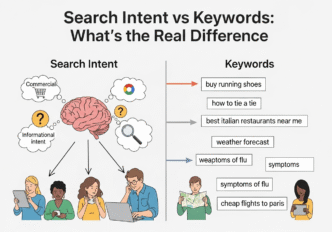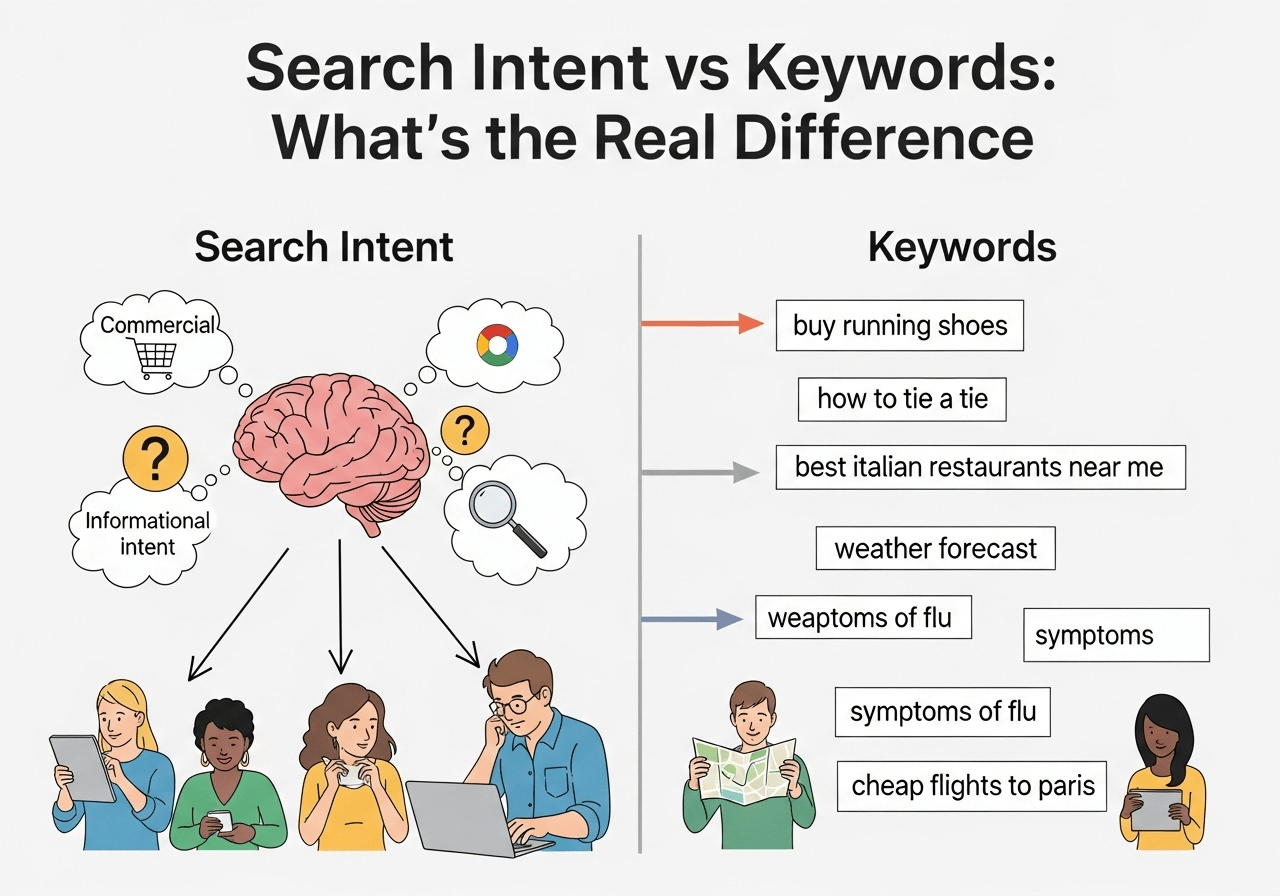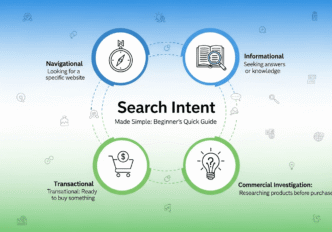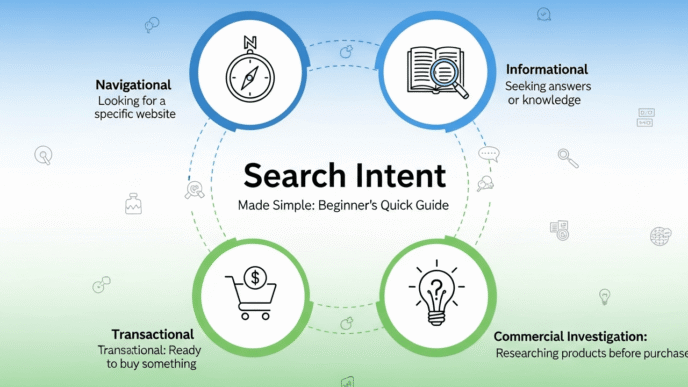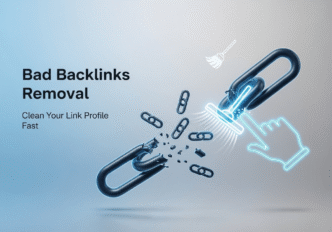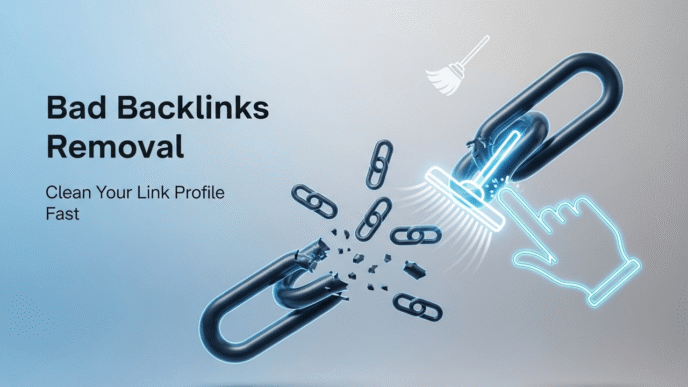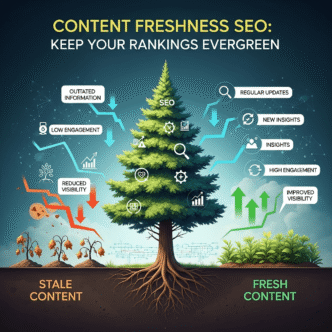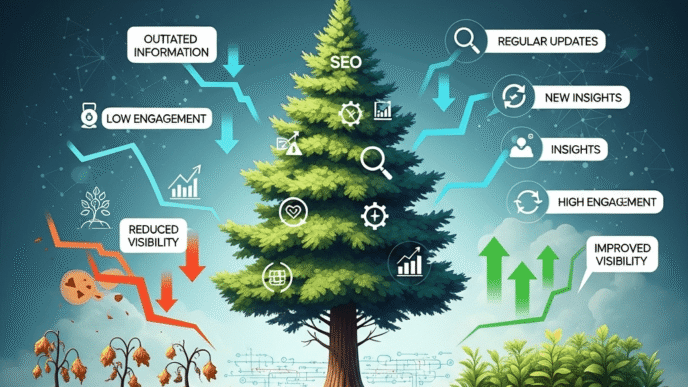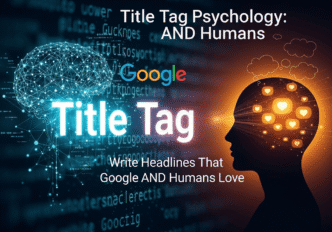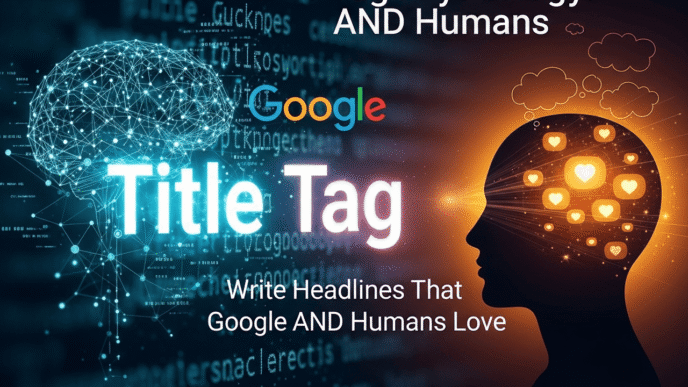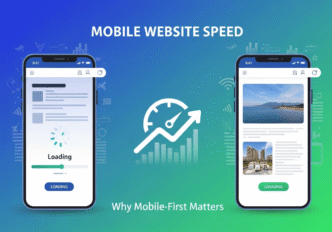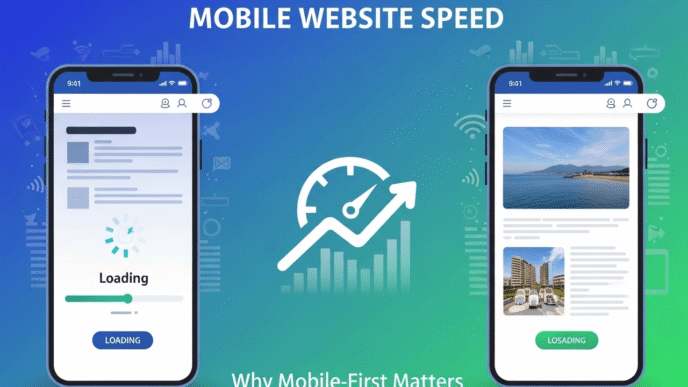Remember when SEO was just about stuffing keywords into content like stuffing a turkey at Thanksgiving? Those days are deader than disco. Yet many marketers still treat search intent vs keyword research as if they’re playing by 2010 rules.
Here’s the reality check: You could rank #1 for a keyword with 50,000 monthly searches and still get zero sales. Meanwhile, your competitor targets a 500-search keyword and builds a million-dollar business. What’s the difference? They understand user intent.
The difference between search intent and keyword research isn’t just semantic – it’s the difference between creating content people actually want versus content that makes Google’s algorithm happy (but leaves users frustrated).
Ready to discover why search intent is more important than keywords and how this shift is revolutionizing modern SEO? Let’s dive in.
Table of Contents
Toggle
What’s the Fundamental Difference Between Search Intent and Keyword Research?
Search intent vs keyword research is like comparing a GPS navigation system to a road map. Both help you reach destinations, but one understands where you actually want to go.
Traditional keyword research focuses on:
- Search volume numbers
- Competition levels
- Exact match phrases
- Ranking difficulty scores
Search intent analysis focuses on:
- User motivation and goals
- Problem-solving needs
- Journey stage identification
- Satisfaction outcomes
Think of keywords as the “what” people search for, while intent reveals the “why” behind those searches.
The Evolution from Volume to Value
Traditional keyword research assumes that higher search volume equals better opportunity. Intent-based keyword research recognizes that relevance trumps volume every time.
Real Example: A fitness coach ranked #1 for “workout routine” (90,000 monthly searches) but got 12 sign-ups. When they shifted to “beginner home workout for busy moms” (1,200 searches), they got 67 sign-ups. Same traffic investment, 5x better results.
Why Is Search Intent More Important Than Keywords in Modern SEO?
Search intent importance has skyrocketed because Google’s algorithm has evolved beyond simple keyword matching. The search engine now prioritizes user satisfaction over keyword density.
Google’s RankBrain Revolution
Google’s RankBrain AI processes 15% of daily searches – that’s 500 million queries focusing on intent rather than exact keywords. The algorithm now asks: “Does this content satisfy the user’s goal?” instead of “Does this content contain the keyword X times?”
Key statistics that prove intent matters:
- 67% of top-ranking pages don’t contain the exact keyword in their title
- Content matching search intent gets 3x more engagement
- Intent-optimized pages have 40% lower bounce rates
- User satisfaction signals account for 30%+ of ranking factors
The User Experience Priority Shift
User-focused SEO recognizes that search engines are user experience delivery systems. When you solve real problems, rankings follow naturally.
| Traditional Keyword Focus | Modern Intent Focus |
|---|---|
| “Best CRM software” targets keyword | “Help me organize customer data” solves problem |
| Measures rankings and traffic | Measures engagement and conversions |
| Creates content around keywords | Creates solutions around user needs |
| Success = higher search volume | Success = satisfied users |
Pro Tip: Stop thinking like an SEO and start thinking like a user. When you solve real problems, keyword rankings become a natural byproduct.
How Has Search Intent Changed Keyword Research Forever?
Keyword research evolution represents the biggest shift in SEO since Google’s inception. We’ve moved from keyword stuffing to user journey mapping.
The Old Way vs The New Way
Traditional keyword research process:
- Find high-volume keywords
- Analyze competition levels
- Create content targeting those keywords
- Hope for rankings and traffic
Modern intent-driven approach:
- Understand user problems and goals
- Map keywords to specific intent types
- Create content solving real user needs
- Measure satisfaction and business outcomes
How Search Intent Changed Everything
Before intent-focus:
- “Dog food” content targeted anyone searching those words
- One-size-fits-all approach for broad keywords
- Success measured by traffic volume alone
After intent-focus:
- “Best grain-free dog food for sensitive stomachs” targets specific user needs
- Tailored content for different user journey stages
- Success measured by user satisfaction and conversions
Case Study: A pet supply company shifted from targeting “dog food” (200k searches) to intent-specific keywords like “organic dog food for allergies” (3k searches). Results? 280% increase in conversion rate and 156% boost in customer lifetime value.
What Does User Intent vs Keywords Mean for Content Strategy?
User intent vs keywords fundamentally changes how you approach content creation. Instead of building content around search terms, you build solutions around user needs.
Intent-First Content Planning
Traditional keyword-first approach:
- Start with keyword list
- Create content fitting those keywords
- Hope it matches user needs
Intent-first content strategy:
- Start with user problems and goals
- Identify keywords that signal those intents
- Create comprehensive solutions
The Four Pillars of Intent-Driven Content
| Intent Type | User Goal | Content Strategy | Keyword Examples |
|---|---|---|---|
| Informational | Learn and understand | Educational content, guides | “How to,” “What is,” “Why does” |
| Commercial | Research before buying | Comparisons, reviews, pros/cons | “Best,” “vs,” “review,” “top” |
| Transactional | Take action or purchase | Product pages, landing pages | “Buy,” “order,” “download,” “hire” |
| Navigational | Find specific website | Brand pages, login pages | Brand names, “[Brand] login” |
Content Mapping by User Journey
Awareness stage (Informational intent):
- Problem identification content
- Educational resources
- Industry insights
Consideration stage (Commercial intent):
- Solution comparison content
- Case studies and proof
- Feature explanations
Decision stage (Transactional intent):
- Product demonstrations
- Pricing information
- Easy conversion paths
Pro Tip: Create content clusters serving the complete user journey. Link informational content to commercial content to transactional pages for maximum conversion potential.
How Does Search Behavior vs Keywords Impact SEO Success?
Search behavior vs keywords reveals the psychology behind queries. Understanding behavior patterns helps you anticipate user needs before they fully form their search queries.
Behavioral Search Patterns
Micro-moment searches:
- “Near me” searches indicate immediate local intent
- “How to” searches show learning intent
- “Best” searches reveal comparison intent
- Brand + “review” shows evaluation intent
Search refinement patterns: Users often search in progressions:
- “Marketing automation” (broad learning)
- “Email marketing automation tools” (narrowing focus)
- “Mailchimp vs HubSpot” (comparison)
- “HubSpot pricing” (decision research)
Intent Signals in Search Behavior
| Behavior Pattern | Intent Signal | Content Opportunity |
|---|---|---|
| Question-based searches | Information seeking | FAQ content, explainer guides |
| Comparison searches | Purchase consideration | Comparison charts, vs content |
| Local + service searches | Immediate need | Local landing pages, contact info |
| Brand + problem searches | Support seeking | Help documentation, tutorials |
Real Example: A software company tracked user search progressions and discovered 73% of customers searched informational terms first, then comparison terms, then specific product terms. They created content for each stage and saw 245% improvement in qualified lead generation.
What Role Does Modern Keyword Research Play in Intent-Based SEO?
Modern keyword research hasn’t disappeared – it’s evolved. Keywords now serve as intent indicators rather than content targets.
Keywords as Intent Signals
Intent-based keyword research uses keywords to understand:
- User motivation levels
- Journey stage positioning
- Problem urgency indicators
- Solution sophistication needs
The New Keyword Research Framework
Step 1: Intent Classification Group keywords by the intent they signal, not by search volume
Step 2: User Journey Mapping Organize keywords by where they fit in the customer journey
Step 3: Content Gap Analysis Identify missing content for specific intent + journey combinations
Step 4: Solution Prioritization Focus on high-intent keywords that align with business goals
Advanced Intent-Keyword Alignment
| Traditional Approach | Intent-Based Approach |
|---|---|
| Target “email marketing” | Target “email marketing for small business owners” |
| Focus on search volume | Focus on user context and needs |
| Create generic content | Create specific solutions |
| Measure rankings | Measure user satisfaction |
Pro Tip: Use keyword research tools to find intent-rich long-tail variations. Tools like AnswerThePublic reveal the questions behind keywords, exposing true user intent.
How Should Intent-Driven Content Differ from Keyword-Focused Content?
Intent-driven content prioritizes user needs over search engine optimization tricks. The result? Content that naturally ranks well because it genuinely helps people.
Content Structure Differences
Keyword-focused content structure:
- Keyword in title, headers, throughout content
- Keyword density optimization
- Internal linking for SEO value
Intent-focused content structure:
- Problem-solution framework
- User experience optimization
- Value-driven internal linking
Writing Style Evolution
Traditional SEO writing:
- Awkward keyword insertion
- Repetitive phrasing
- SEO-first, user-second approach
Intent-driven writing:
- Natural, conversational tone
- Problem-solving focus
- User-first, SEO-follows approach
Measuring Content Success
| Traditional Metrics | Intent-Based Metrics |
|---|---|
| Keyword rankings | User engagement depth |
| Search traffic volume | Conversion quality |
| Page views | Problem resolution rate |
| Bounce rate | User satisfaction signals |
Case Study: A marketing agency rewrote their service pages from keyword-focused to intent-focused. Instead of “SEO services,” they created “Help your business get found by customers searching for your solutions.” Result? 34% increase in consultation requests and 67% improvement in client retention.
For comprehensive intent optimization strategies, explore our detailed Search Intent Mastery Guide with advanced frameworks.
What Are the Biggest Mistakes in Understanding Intent vs Keywords?
Even experienced marketers stumble when transitioning from traditional keyword research to user intent vs keywords thinking.
Mistake #1: Keyword Volume Obsession
Problem: Chasing high-volume keywords regardless of intent alignment Solution: Prioritize intent relevance over search volume numbers
Mistake #2: One-Size-Fits-All Content
Problem: Creating broad content trying to target multiple intents Solution: Create specific content for specific intent types
Mistake #3: Ignoring Intent Evolution
Problem: Assuming intent stays static for keywords Solution: Regular intent audits and content updates
Mistake #4: Tools Over Users
Problem: Trusting keyword tools over actual user research Solution: Combine tool data with real user conversations and feedback
Pro Tip: Spend 30% of your research time on keyword tools and 70% understanding your actual users through surveys, interviews, and support ticket analysis.
How Can You Transition from Keywords to Intent-Based Strategy?
Search intent vs keyword volume importance requires a strategic shift in how you approach SEO. Here’s your roadmap for evolution.
Phase 1: Intent Audit (Week 1-2)
- Classify existing content by intent type
- Analyze current keyword targets for intent alignment
- Identify content gaps in your intent coverage
- Map user journey touchpoints for each intent stage
Phase 2: Research Revolution (Week 3-4)
- Implement intent-first keyword research processes
- Study actual user conversations in forums and social media
- Analyze competitor intent strategies beyond keyword targeting
- Create user persona intent profiles
Phase 3: Content Transformation (Week 5-8)
- Rewrite top-performing pages with intent focus
- Create intent-specific content clusters
- Develop user journey content sequences
- Optimize internal linking for intent progression
Phase 4: Measurement Evolution (Ongoing)
- Track intent-based success metrics
- Monitor user satisfaction signals
- Measure business outcome improvements
- Iterate based on user feedback
Tools for Intent-Based Research
Free intent research tools:
- Google’s “People Also Ask” sections
- Reddit and Quora conversations
- Google Trends for intent pattern analysis
- Your own customer support data
Premium intent analysis tools:
- Semrush Intent Analysis features
- Ahrefs Content Gap tool
- BuzzSumo Question Analyzer
- Hotjar for user behavior insights
Pro Tip: Start your intent research with your existing customers. Survey them about their search behavior and decision-making process. This reveals intent patterns no tool can discover.
For advanced implementation strategies, dive deeper into our comprehensive Intent-Based SEO Framework.
Your Intent-First SEO Action Plan
Ready to master how search intent changed keyword research? Here’s your implementation roadmap:
Week 1: Foundation Assessment
- Audit top 20 pages for intent alignment
- Categorize current content by intent type
- Identify quick wins for intent optimization
- Set baseline metrics for comparison
Week 2: User Research Deep Dive
- Interview 5-10 customers about their search behavior
- Analyze support tickets for common user problems
- Study competitor intent strategies
- Create detailed user journey maps
Week 3: Content Strategy Redesign
- Develop intent-based content calendar
- Create content templates for each intent type
- Plan content cluster architecture
- Design internal linking strategy
Week 4: Implementation and Testing
- Launch first intent-optimized content pieces
- A/B test different intent approaches
- Monitor early performance indicators
- Gather user feedback on new content
Frequently Asked Questions
Is keyword research dead if intent matters more?
No, keyword research evolved rather than died. Keywords now serve as intent indicators and help identify user needs. The difference is using keywords to understand intent rather than just targeting search volume.
How do I find intent-rich keywords?
Focus on long-tail keywords with clear intent signals. Question-based keywords (“how to”), comparison terms (“vs”), and action words (“buy,” “hire”) reveal strong intent patterns.
Can one piece of content target multiple intents?
Generally, it’s better to focus on one primary intent per page. However, comprehensive content can acknowledge secondary intents through additional sections or related content suggestions.
How do I measure intent-based content success?
Look beyond rankings to user engagement metrics: time on page, conversion rates, user satisfaction surveys, and business outcomes like leads and sales.
What if my keyword tools don’t show intent data?
Combine tool data with manual research. Analyze SERPs, study user forums, conduct customer interviews, and use Google’s “People Also Ask” sections for intent insights.
How long does it take to see results from intent-based SEO?
Initial improvements typically appear within 4-8 weeks, with significant gains visible in 3-6 months. Intent-based content often performs better long-term as it truly serves user needs.
Final Thoughts: Intent Is the Future of SEO
Understanding search intent vs keyword research isn’t just about keeping up with SEO trends – it’s about building sustainable business growth through genuine user value.
Why search intent is more important than keywords comes down to one simple truth: Google’s mission is organizing the world’s information to make it universally accessible and useful. When your content genuinely helps users accomplish their goals, Google naturally rewards you with visibility.
Your competitors are still playing the keyword volume game while you’ll be playing the user satisfaction game. Guess who wins long-term?
The shift from keywords to intent represents the maturation of SEO from a technical manipulation tactic to a user experience discipline. Intent-driven content doesn’t just rank better – it converts better, engages better, and builds stronger businesses.
Remember: Keywords are the language users speak, but intent is what they actually mean. When you speak fluent intent, you create content that doesn’t just get found – it gets results.
Start thinking like your users, not like a search engine. The rankings will follow naturally.
Ready to master the complete intent-based SEO framework? Explore our advanced Search Intent Strategy Guide for professional-level techniques that’ll transform your content strategy and business results.

